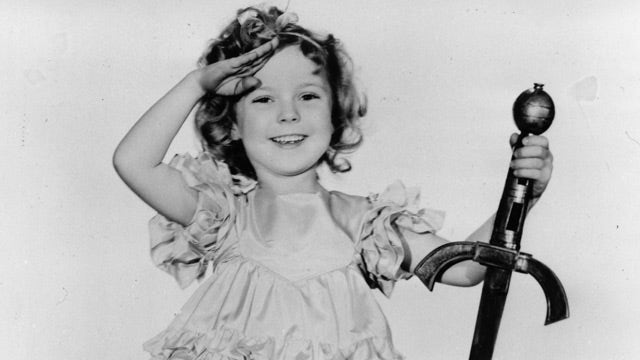Shirley Temple Black, who as a dimpled, ringlet-haired moppet starred in a series of winsome films that lifted the spirits of millions during the hard days of the Depression, then retired from the screen at 22 and eventually went on to a diplomatic career, died surrounded by family at her home in Woodside, Calif. She was 85.
Temple was the most famous child star of her time and arguably of all time, beginning her film career at age three and becoming the symbol of upbeat family entertainment during an era when many had little to smile about.
By six, she'd received a miniature Academy Award and left her hand and footprints in cement at Grauman's Chinese Theatre.
Her roles tended to follow a template: she was constantly cheerful, smiling, optimistic and pure hearted -- sometimes without one parent, sometimes an orphan, but always able to bring joy to the coldest-hearted characters and love to those who yearned for it.
Temple also was a merchandising goldmine: dolls, clothes, dishes, cutout books and numerous other items appeared in her likeness. There was even a non-alcoholic drink named after her: the Shirley Temple (ginger ale, orange juice and grenadine, topped with a maraschino cherry).
But her days as an internationally famous star effectively ended with her childhood and her life took a strikingly different path.
She married twice and gave birth to three children before venturing onto the political stage, serving as US ambassador to both Ghana and Czechoslovakia, a US representative to the United Nations and chief of protocol in the administration of President Gerald Ford.
A widow, Temple is survived by her three children, Linda, Charlie and Lori.
The little girl who tap danced her way into the heart of millions was born April 23, 1928 in Santa Monica, California to businessman George Temple and his wife, Gertrude.
She was sent at three to dance school, where she was seen by two producers for one-reel short films, who launched her career.
By the time she was six, Temple was under contract to Fox Films and her breakthrough came in 1934's "Stand Up and Cheer!" followed by "Little Miss Marker."
That same year, her trademark song, "On the Good Ship Lollipop" was introduced in "Bright Eyes."
Audiences struggling through the Depression couldn't get enough of her. Then- President Franklin Roosevelt said, "It is a splendid thing that for just 15 cents an American can go to a movie and look at the smiling face of a baby and forget his troubles."
More films followed, including "Curly Top," "The Littlest Rebel," "Dimples,", "Wee Willie Winkie," "Heidi" and "Rebecca of Sunnybrook Farm."
She was "just absolutely marvelous, greatest in the world," director Allan Dwan told filmmaker-author Peter Bogdanovich in his book "Who the Devil Made It: Conversations With Legendary Film Directors." "With Shirley, you'd just tell her once and she'd remember the rest of her life," said Dwan, who directed "Heidi" and "Rebecca of Sunnybrook Farm." "Whatever it was she was supposed to do -- she'd do it. ... And if one of the actors got stuck, she'd tell him what his line was -- she knew it better than he did."
One of her last was "The Bachelor and the Bobby-Soxer" with Cary Grant, in which she played a high school student.
But as she got older, her popularity waned and in December 1950, Temple announced her official retirement from films. In all, according to her website, she made 14 short films and 43 feature films.
By the time she bowed out, Temple had married Jack Agar, a soldier, at 17 and divorced him four years later after giving birth to daughter Linda.
In 1950 she married Charles Black, a former naval officer whom her website describes as her "true soulmate." They remained wed until his death in 2005 and were the parents of Charlie Jr. and Lori.
In 1958, Temple briefly returned to the performing world as host and narrator of "Shirley Temple's Storybook" on NBC. It was reworked and reappeared two years later as the "Shirley Temple Show" but neither lasted.
Politics beckoned next and Temple, a Republican, ran unsuccessfully for a seat in the US House of Representatives in 1967.
In 1972 she was diagnosed with breast cancer and became one of the first prominent women, followed by Betty Ford, to discuss it openly.
After serving as US representative to the United Nations in 1969, Temple was appointed US Ambassador to the African nation of Ghana in 1974, Chief of Protocol of the US in 1976 and US Ambassador to Czechoslovakia in 1989.
In later years, she lived in northern California and wrote a 1988 autobiography, "Child Star."
During a 1996 interview, she said she loved both politics and show business.
"It's certainly two different career tracks," she said, "both completely different but both very rewarding, personally."
The Associated Press contributed to this report.







